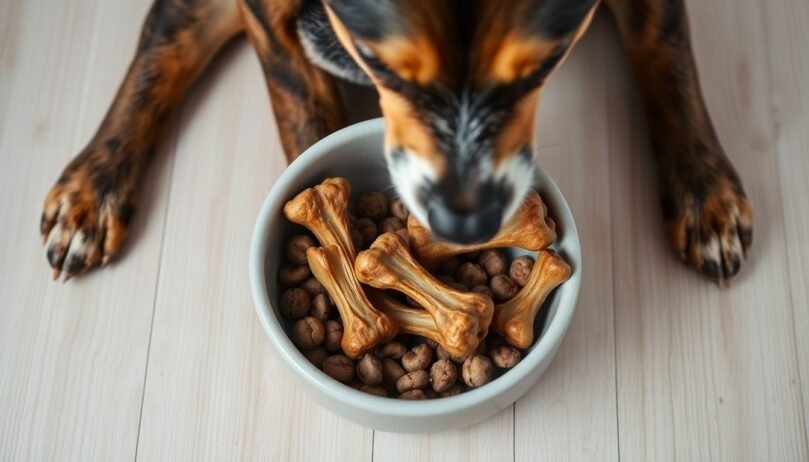Are Bones Good For Dogs ?
- 29 February 2024
- BuyAPet Editorial Team
- All Dogs, Dog Health
Are Bones Good For Dogs ?
Bones can help—and harm. Learn which are safe, which to avoid and how to supervise chewing.
Overview
Are Bones Good for Dogs? The Ultimate Guide to Safe Chewing
very dog owner knows that canines love to chew. Picture this: your furry friend, tail wagging, happily gnawing on a bone. It can be a delightful sight! But the question remains: are bones truly good for dogs? The answer isn't straightforward. While bones can offer benefits, they also come with risks. Let's break down everything you need to know about giving bones to your dog.
The Nutritional Benefits of Bones for Dogs
Calcium and Phosphorus Content
Bones are packed with essential minerals like calcium and phosphorus, vital for your dog's bone density and joint health. According to studies, these minerals are crucial for maintaining strong bones and preventing conditions like osteoarthritis. For instance, a 100g serving of raw beef bone may contain up to 180mg of calcium and 90mg of phosphorus. Regularly consuming these nutrients contributes to your dog's overall health.
Dental Health Advantages
Chewing on raw bones can provide dental benefits. The act of chewing helps clean your dog's teeth and reduce plaque buildup. According to veterinarians, this natural cleaning method can support dental hygiene and freshen breath. Regular bone chewing could be an enjoyable way to keep your pup's smile bright!
Natural Instincts and Behavioral Enrichment
Dogs have an innate desire to chew, rooted in their ancestral behaviour. Providing bones or safe chew options stimulates their natural instincts, reducing boredom and anxiety. A happy dog is a well-behaved dog, and engaging them with bones enriches their environment.
Types of Bones Suitable (and Unsuitable) for Dogs
Safe Bone Choices
Not all bones are created equal. Here are safe options for your dog
Raw Marrow Bones: Soft and nutritious, these bones are great for chewing.
Bully Sticks: A popular chew that offers longer-lasting enjoyment without the risks of splintering.
Large Raw Bones: Appropriate for bigger breeds, these provide a great outlet for chewing.
When choosing bones, consider your dog's size. For instance, small breeds should have smaller bones to prevent choking.
Bones to Avoid
Some bones can be harmful. Avoid these types
Cooked Bones: Cooking makes bones brittle and prone to splintering.
Poultry Bones: These can easily break and pose choking hazards.
Small Bones: Small pieces can be easily swallowed, leading to blockages or choking.
Alternatives to Bones
If you're wary of bones, there are great alternatives
Dental chews that promote oral health.
Rubber chew toys that withstand heavy chewing.
Rawhide options, though these should be carefully monitored.
Potential Dangers of Giving Dogs Bones
Choking Hazards
The risk of choking on bone fragments is real. In fact, statistics show that countless veterinary emergency visits are linked to choking incidents involving bones. It's crucial to supervise your dog while they enjoy a bone to quickly address any potential problems.
Digestive Issues
Bone fragments can lead to severe digestive issues, including constipation or blockages. Veterinary experts warn that swallowed pieces can cause significant harm. Monitoring your dog is essential to catch any signs of distress early.
Dental Damage
While chewing can promote dental health, it can also result in dental damage. Dogs risk chipping teeth or, in extreme cases, breaking jaws when chewing on hard bones. It's vital to choose bone types that align with your dog's chewing habits.
Choosing and Supervising Bone Chewing
Selecting the Right Bone
While chewing can promote dental health, it can also result in dental damage. Dogs risk chipping teeth or, in extreme cases, breaking jaws when chewing on hard bones. It's vital to choose bone types that align with your dog's chewing habits.
Choosing and Supervising Bone Chewing
Selecting the Right Bone
Choosing the right bone is key. Consider your dog's
Breed: Larger breeds may require bigger bones.
Size: Ensure the bone isn't too small to prevent choking.
Age: Puppies need softer options as they develop their chewing skills.
Safe Chewing Environment
Create a safe space for your dog to enjoy their bones. Clear away objects they might knock over, and ensure they have plenty of room.
Monitoring Your Dog
While your dog enjoys their bone, keep an eye on them. Look for signs of discomfort or struggle. If they seem to be chewing too aggressively or swallowing large pieces, it might be time to intervene.
Conclusion: Making Informed Decisions about Bones and Your Dog
In conclusion, bones can offer nutritional and behavioural benefits for dogs when selected and supervised properly. Always consult your veterinarian for personalised guidance tailored to your dog's needs. Remember, ensuring your pup's happiness and health is the ultimate goal. Consider talking to a veterinary nutritionist for the best options available. Happy chewing!
FAQs
Are cooked bones safe? +
No. Cooking makes bones brittle and prone to splintering—stick to raw, vet‑advised options only.
What size bone should I pick? +
Larger than your dog’s muzzle so it can’t be swallowed; match density to chewing style.
Can bones replace brushing? +
Chewing helps but doesn’t replace dental care. Brush regularly and see your vet for checks.
Always supervise chewing and consult your vet—especially for puppies, seniors or dental issues.
